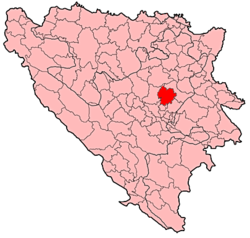Vareš
|
Vareš Вареш |
||
|---|---|---|
|
||
 Location of Vareš within Bosnia and Herzegovina. |
||
| Location of Vareš | ||
| Coordinates: 44°10′N 18°20′E / 44.167°N 18.333°E | ||
| Country |
|
|
| Government | ||
| • Municipality president | Zdravko Marošević (HDZ BiH) | |
| Area | ||
| • Total | 390,1 km2 (1,506 sq mi) | |
| Population (2013 census) | ||
| • Total | 9,556 | |
| • Density | 25/km2 (60/sq mi) | |
| Time zone | CET (UTC+1) | |
| • Summer (DST) | CEST (UTC+2) | |
| Area code(s) | +387 32 | |
| Website | http://www.vares.info | |
Vareš is a town and municipality in central Bosnia and Herzegovina, famous for the local mining activities and production of iron. It is part of the Zenica-Doboj Canton and the Federation of Bosnia and Herzegovina.
The town of Vareš has a long history with remains of metallurgical activities dating back to Bronze Age. Also during the Roman era, the town was famous for its miners and smiths.
During Middle Ages the Bosnian kings had their center in close proximity of the modern city of Vareš. Bosnia's greatest king, Tvrtko, considered the Vareš' village Duboštica for the center of his kingdom, since it was the mining center of his country.
The remains of the medieval royal city and castle Bobovac were recently proclaimed as national monuments, as was the Catholic Church of St. Michael in the town of Vareš. Oldest preserved Catholic church in Bosnia can be found in the town, built in early 17th century. The town was earlier dominated by Catholic population. The church books are among the oldest preserved in Bosnia and date back to 1643.
During the Austrian rule of Bosnia and Herzegovina the iron-works of Vareš were an important exporter of various iron products to the rest of the Habsburg empire. In 1891, the first blast furnace in Bosnia and Herzegovina was built there. That blast furnace still exists, but it ceased its operations in 1990.
In the 1910s World War I, men of the town were subject to draft, and served in the regiment BH-1, formally based in Sarajevo. They mostly saw action in the Italian and Galician fronts. It should be noted that the church bell was taken and melted so it could be used to produce war material.
During the Second World War, Vareš was an Ustashe stronghold. Due to the value of its industry the city was well defended, and saw several attacks by Partisans and Chetniks on both the city and surrounding villages.
...
Wikipedia


